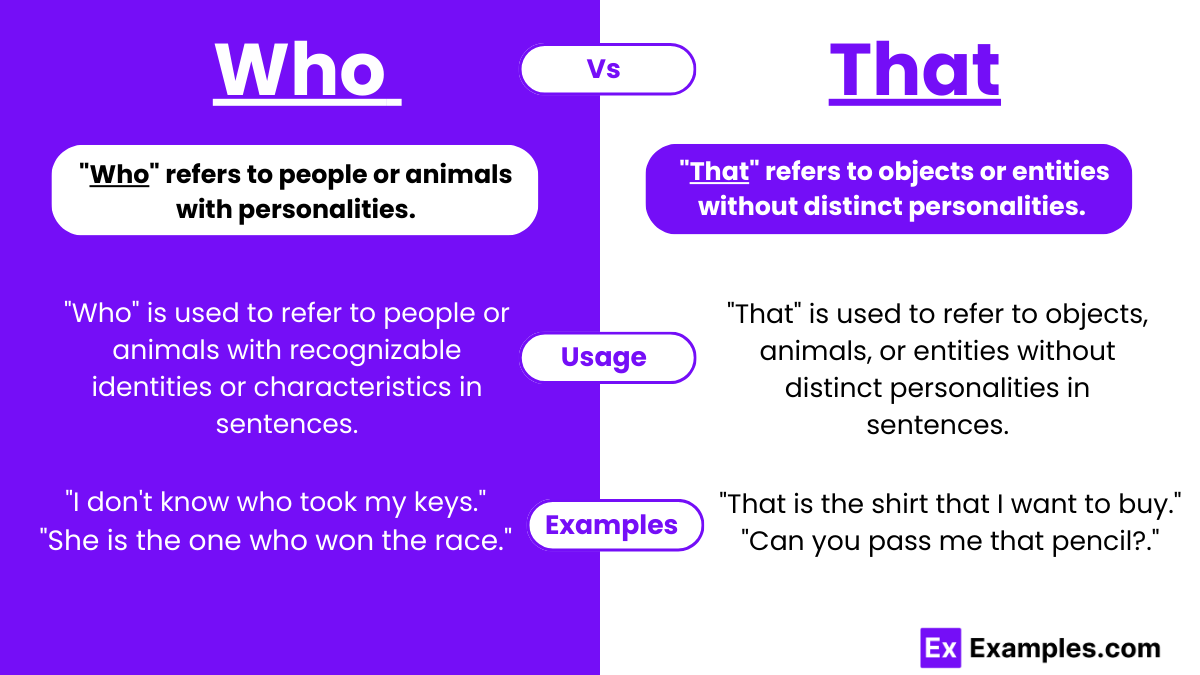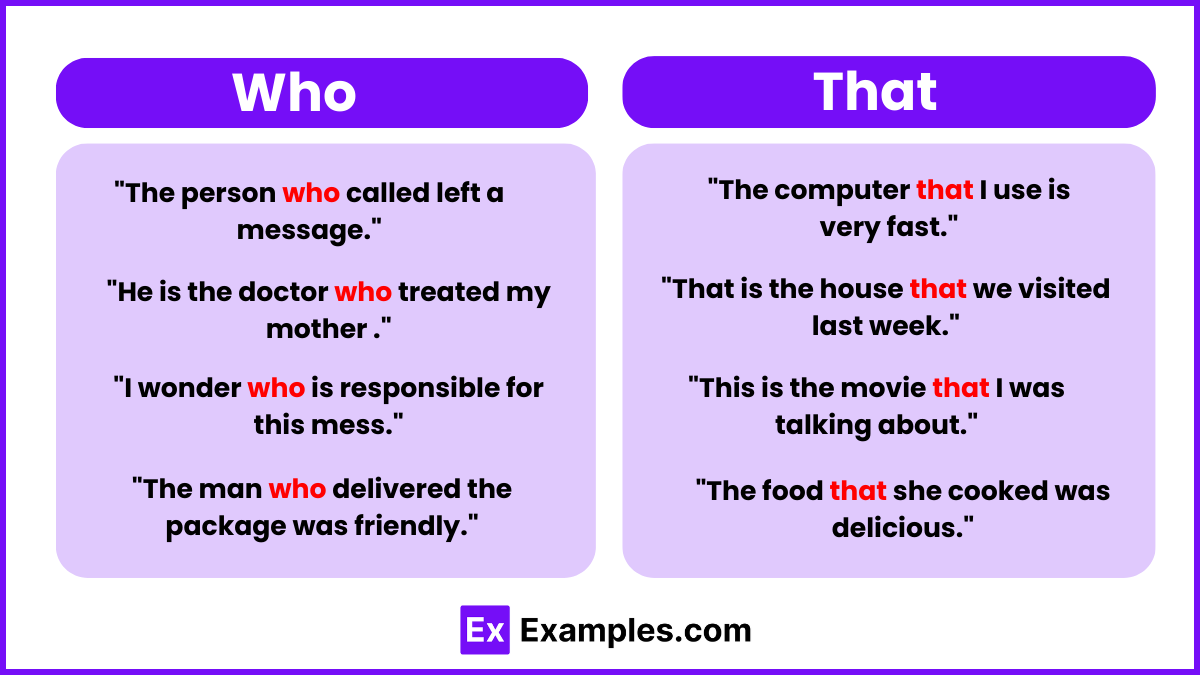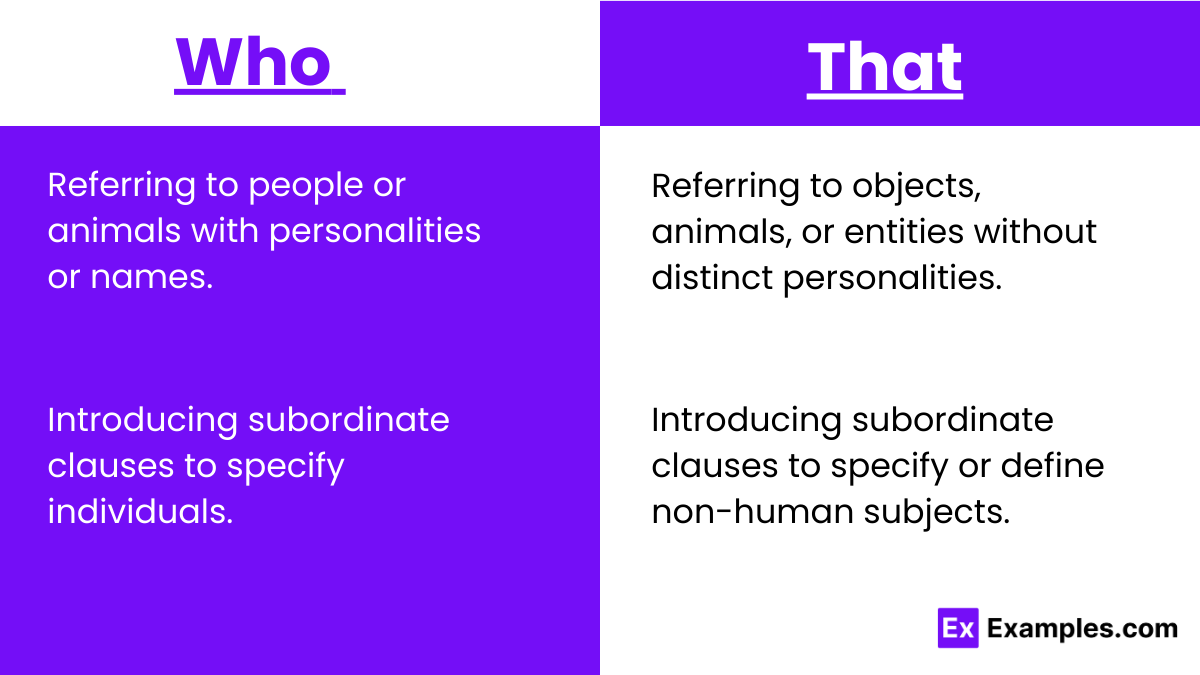Who vs That – Examples, Differences, Usage, Tips
In the vast realm of grammar, the distinction between “who” and “that” stands as a subtle yet pivotal point of discussion. For students navigating the intricacies of language, understanding when to employ each pronoun is akin to unlocking a door to clearer communication. While both “who” and “that” serve as relative pronouns, their usage diverges in contexts that demand precision and clarity. This article endeavours to unravel the nuanced differences between these pronouns, empowering students with the linguistic finesse needed to navigate the maze of English grammar confidently.
At first glance, “who” and “that” might appear interchangeable, but delving deeper unveils their distinct roles in sentence structure. “Who” typically refers to people or, in some cases, animals with personalities or names, adding a touch of humanity to the sentence. Conversely, “that” extends its reach beyond individuals, encompassing objects, animals, or entities without distinct personalities. By exploring examples and dissecting real-world applications, this article aims to equip students with the tools necessary to wield “who” and “that” with precision, enhancing their mastery of the English language.
Who and That – Meanings
Who: “Who” is a relative pronoun used to refer to people or, in some cases, animals with personalities or names. It introduces a subordinate clause and is often employed in questions, statements, or clauses to specify individuals. “Who” adds a personal touch to sentences, indicating a connection to living beings or entities with recognizable identities or characteristics. In essence, “who” infuses sentences with a sense of humanity, portraying individuals as more than mere subjects of discussion but rather as distinct personalities or entities deserving of recognition and consideration within the narrative context.
That: “That” is a relative pronoun utilized to refer to objects, animals, or entities without distinct personalities or names. It introduces a subordinate clause and is commonly employed in various contexts to specify or define non-human subjects. Unlike “who,” which adds a personal touch to sentences, “that” is more impersonal and versatile in its usage, encompassing a broader range of entities or objects. “That” serves to clarify or specify the subject of discussion, providing essential information within the narrative framework without necessarily invoking the sense of humanity associated with “who.”
Summary
In summary, while both “who” and “that” serve as relative pronouns, their usage diverges based on the presence of distinct personalities or names. “Who” adds a personal touch to sentences, referring to individuals or animals with recognizable identities, imbuing narratives with a sense of humanity and connection. Conversely, “that” is more impersonal, encompassing objects or entities without distinct personalities, providing essential information without invoking the same sense of humanity as “who.” Each pronoun contributes uniquely to sentence structure, clarifying and specifying subjects within the narrative framework.
Difference Between Who and That
Exploring the differences between “who” and “that” elucidates their distinct roles in sentence structure and usage. Let’s delve into a comparative analysis to understand their nuanced differences.
| Aspect | Who | That |
|---|---|---|
| Refers to | People or animals with personalities or names. | Objects, animals, or entities without distinct personalities or names. |
| Usage | Adds a personal touch, infusing sentences with a sense of humanity. | More impersonal and versatile, clarifying subjects without invoking personal attributes. |
| Introduction | Introduces subordinate clauses in sentences. | Also introduces subordinate clauses, providing essential information. |
| Context | Employed in questions, statements, or clauses to specify individuals. | Commonly used to specify or define non-human subjects. |
| Personalization | Portrays individuals with recognizable identities or characteristics. | Encompasses a broader range of entities or objects, focusing on clarification. |
| Narrative Impact | Infuses narratives with a sense of humanity and connection. | Provides essential information within the narrative framework. |
| Recognition | Indicates a connection to living beings or entities deserving recognition. | Serves to clarify or specify the subject of discussion. |
| Identity | Highlights individuals as distinct personalities deserving of consideration. | Clarifies subjects without invoking personal attributes. |
| Versatility | Limited to people, animals, or named entities. | Extends to objects, animals, or entities without distinct personalities. |
| Impact | Adds personal touch and depth to sentences. | Enhances clarity and specificity within the narrative. |
Examples of Who and That
Exploring examples of “who” and “that” illuminates their distinct usage in sentence structure and context. Let’s delve into specific instances where each pronoun is aptly employed.
Examples of Who:
- The person who rescued the kitten deserves recognition.
- Sarah, who is an accomplished pianist, performed at the concert.
- Do you know someone who speaks multiple languages?
- The friend who always lends a helping hand is invaluable.
- She is the one who inspires us all with her perseverance.
Examples of That:
- The book that I borrowed from the library is due tomorrow.
- Can you pass me the pen that is on the desk?
- The dog that barks loudly lives next door.
- Is there a store nearby that sells fresh produce?
- The idea that you proposed sounds interesting.
When to Use Who and That
Understanding when to use “who” and “that” enhances sentence clarity and precision. Let’s explore the contexts in which each pronoun is appropriately employed to convey specific meanings and nuances.
Usage of “Who”:
- Referring to people or animals with personalities or names.
- Introducing subordinate clauses to specify individuals.
- Adding a personal touch, infusing sentences with humanity.
- Employed in questions, statements, or clauses regarding individuals.
- Indicating a connection to living beings deserving recognition.
Usage of “That”:
- Referring to objects, animals, or entities without distinct personalities.
- Introducing subordinate clauses to specify or define non-human subjects.
- Providing essential information without invoking personal attributes.
- Commonly used to clarify or specify the subject of discussion.
- Encompassing a broader range of entities or objects, focusing on clarification.
Rule for Determining Whether to Use Who and That
-
For People, Use “Who”:
- Reserve “who” exclusively for referring to individuals, including people or animals with distinct personalities or identities.
-
For Inanimate Objects, Use “That”:
- Employ “that” when discussing inanimate objects, entities, or non-human subjects devoid of personal characteristics.
-
For Classes or Types, Use “That”:
- Utilize “that” to denote a class or type of person, such as referring to a team or group collectively.
When deciding between “who” and “that,” adhere to these straightforward guidelines. “Who” is tailored for individuals, while “that” encompasses objects or broader classifications. This rule ensures clarity and precision in language usage, facilitating effective communication across various contexts.
Tips for Who and That
- Identify the Subject: Determine whether the subject of reference is a person, object, or class/group.
- Use “Who” for Individuals: Employ “who” exclusively when referring to specific people or animals with distinct personalities.
- Reserve “That” for Objects: Utilize “that” when discussing inanimate objects or entities devoid of personal characteristics.
- Consider Collective Nouns: Use “that” when referring to a class or type of person, such as a team or group.
- Review Context: Analyze the context of the sentence to ensure the appropriate pronoun choice aligns with the intended meaning.
- Maintain Consistency: Once a pronoun choice is made, maintain consistency throughout the text for clarity.
- Clarify Ambiguities: If unsure, opt for clarity by using “who” for individuals and “that” for objects or groups.
- Revise for Precision: During proofreading, revise sentences to ensure the chosen pronoun effectively conveys the intended meaning without ambiguity.
FAQs
When can I avoid using that?
You can avoid using “that” when the sentence remains clear without it. However, its omission might affect sentence flow, so use discretion.
Is using that in a sentence bad?
Using “that” is not inherently bad; it depends on context. It’s commonly used and grammatically correct when referring to objects or classes/groups.
Are who and that interchangeable?
While “who” and “that” have specific roles, they might be interchangeable in informal contexts. However, for clarity and precision, adhere to their respective guidelines.





